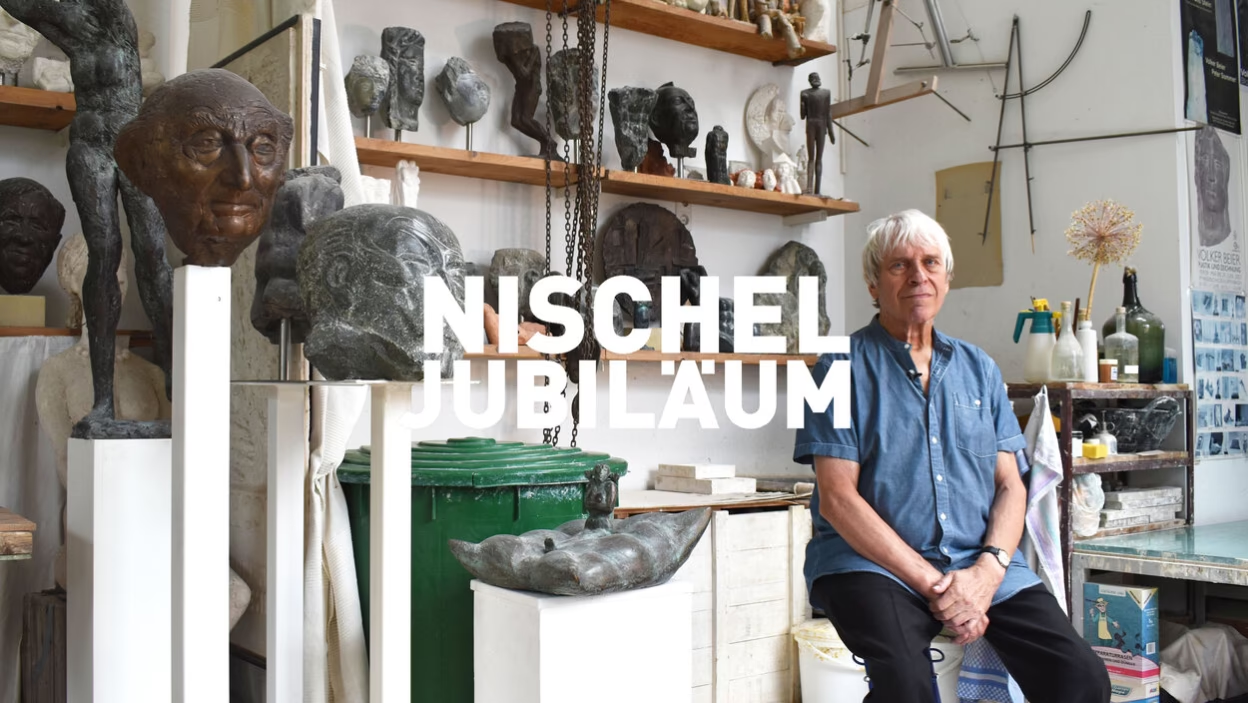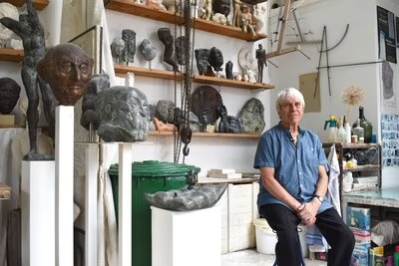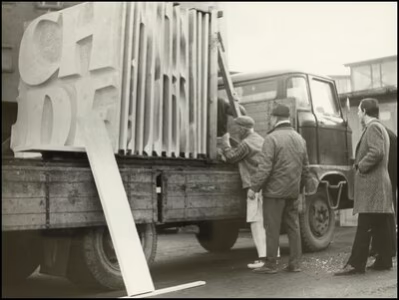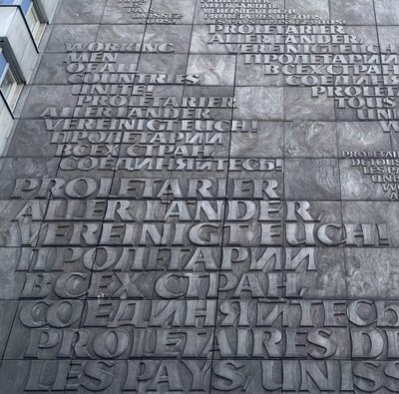Nischel anniversary: companions remember
Two years, two artists, 76 designs
Volker Beier, sculptor

Each of the 174 plates bears his signature: Volker Beier has worked them all by hand. Together with the artist Heinz Schumann, the sculptor designed and produced the writing mirror behind the Karl Marx head. In this interview, he talks about the creative process, difficulties and rejected proposals.
How did it come about that you received the commission for the writing mirror?
Heinz Schumann had asked me if I could do it with him, as I already had some experience as a sculptor. That's how the commission came about. It was: "Font design behind the Karl Marx Monument".
Did you have certain specifications?
No, we were completely free. Lew Kerbel had ideas that looked different. He had already made suggestions that we all couldn't accept, and that's how the lettering solution that can be seen behind the monument today came about.
What suggestions did Lew Kerbel have?
Lew Kerbel had suggestions to create a huge relief of a chain blaster on the 400 square metre surface. In other words, something very heroic that nobody could accept across the board.
Why did you reject it?
Because it didn't fit in. It was already a rethink to put such a large head in this place, but after the folding (editor's note: the "party saw") was built, the space was just right. You could tell that Lew Kerbel had thought it through very well, that the square was justified and that the architecture visually incorporated the head, and that actually convinced us all.
How was the collaboration between you and Heinz Schumann?
We have always got on very well. We then decided and sketched together, but the sketches had to bear a uniform signature, so I later gave the whole thing my sculptural signature.
How many sketches did you need before you found the right one?
76 - That was because the statics of the building didn't allow for any other solution: we couldn't work with natural stone as had been planned until then, namely Rochlitz porphyry - the local material - but we had to switch to a lightweight material and that's why we came up with aluminium. It is a hydronalium alloy that is resistant to seawater, because we had a large concentration of chemicals in Chemnitz and it was important to counteract this. The writing surface could not be allowed to corrode. And this hydronalium alloy has proven over the years that it has consistently maintained this beautiful silver-grey value. That was important to us.
What was the intention behind the typeface?
It's a wide-ranging, multilingual story that concerns everyone. It's an idea that is very important in the world.
How did you go about choosing the languages?
It was our common wish that the writing mirror should have an international impact and it was a very important story for our city.
What memories do you have of the inauguration?
Very, very good: It was well received and there were lots of interviews, there were also lots of school classes and that was really good public relations work. We were also able to see beforehand how the Karl Marx Monument itself was erected and welded together from the many parts. It was quite funny to see it from above from our scaffolding when we were setting the font mirror.
What was your creative process for the writing mirror like?
We modelled the typeface mirror 1:1, drew it 1:1 in what was then the Marble Palace, then it was manufactured at VEB Stuck according to the drawing and I then devoted myself to these 400 square metres piece by piece every few days when VEB Stuck built this typeface. Then I modelled the structure so that there was a uniform handwriting across the entire typeface. What I know about the 400 square metre font is that nothing of this size had ever been designed in the world before. At the time, it was the largest font surface. Then, of course, everything went to the structural engineer Christian Weise, who made a good suspension system for the panels - they were hung in brackets at the top and inserted into springs at the bottom with an expansion of two centimetres so that the material could work properly. They are all inserted into each other in such a way that you can never lift any of them out, so nothing can happen there either.
Were you under any time pressure to complete the typeface mirror?
Not really. We just had to contact various companies who had to do some minor finishing work on the panels.
Did you supervise the transport and hanging of the panels?
Yes, we did it ourselves. Four of us hung the panels within a week. They are so heavy that you can just about lift them and we didn't need such large lifting gear. The scaffolding floors were made in such a way that we had to lift the panels a good 20 centimetres in. That went surprisingly well. We started from the bottom and always hung the panels one after the other up to the top.
What role did the artwork play in your sculptural work?
It played a major role, so I was of course able to create much larger projects afterwards.
Did you realise at the time that you were creating a piece of the city's history?
I didn't realise it that much, no. We were so firmly anchored in the office for architecture-related art and they managed and steered it very well. Everyone did their job and had their own area and others decided on it.
What did you think back then when you got the commission?
I thought it was a nice challenge and I enjoyed it.
What impresses you about the Karl Marx Monument as a work of art?
That it forms an ensemble and that the architecture, the whole thing, stands its ground. I'm also impressed by the fact that there's a lot going on around it, with a lot of people, that a lot of people are committed to it. That's why I have to say I'm very much in defence of the architecture. If you simply take something away, then the monument floats back and forth visually.
What do you think about the Karl Marx Monument today?
I think exactly the same as I did back then: That the monument had a certain symbolism for the city, which was called Karl Marx City. That was important.
Do you have any other stories to tell about the monument?
One of the police officers who had always kept an eye on the monument once said that he had heard something in the monument that sounded like something had fallen off. I was then asked by the city if that was possible. I then explained that it couldn't be and that nobody could climb into the Karl Marx head. I saw for myself how the last piece was welded. It was just fun to see the monument in the making. It was interesting and something was created jointly by Russians and Germans.




